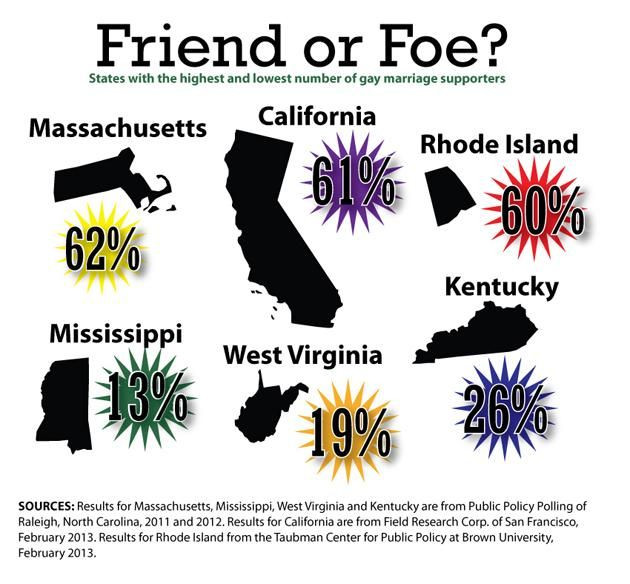Gay Marriage In The United States - As Told By Infographics

Poll after poll tells us that the United States is rapidly becoming more supportive of same-sex marriage.
Support for LGBT marriage equality has been steadily increasing across practically every demographic, although almost half of Americans – about 47 percent – still oppose it. But as recently reported by Gallup, those who oppose same-sex marriage rights generally do so for one reason: Because of their religious beliefs. And even that is becoming increasingly rare among the younger generations – even those who self-identify as Republicans – showing that, these days, opposition to gay marriage isn’t as much a partisan position as a generational divide. And we know who will likely win that fight.

The Pew Research Center recently published one of the more comprehensive looks at how gay marriage is viewed in the U.S. across various demographics. The nonpartisan organization notes that the long-term shift in support for same-sex unions is “unambiguous” – in 2003, most Americans (58 percent) opposed gay marriage, while just a third (33 percent) were in favor. Barely 10 years later, Pew’s most recent survey concluded 49 percent of the nation now agree gay and lesbian couples should have the right to marry, compared to 44 percent who are opposed.
The difference of opinion, when analyzed by age, is stark. Seventy percent of “Millenials” – young adults currently between the ages of 18 and 32 – now favor same-sex marriage. What’s significant is millenial support has skyrocketed in the last decade (in 2003, only 51 percent were in favor), indicating young people are swiftly becoming more accepting of marriage equality, a trend that will likely continue.

Just a few years ago, it would have been almost unthinkable for a Republican lawmaker – particularly one in Congress – to vocally support same-sex marriage. These days the party, while still largely opposed, is discussing how to adapt its platform on the issue if it wants to survive into the future.
About 27 percent of Republicans currently support gay marriage rights, according to Pew, compared to 59 percent of Democrats and 57 percent of independents. But younger Republicans, as noted before, are increasingly becoming more supportive of marriage equality, indicating that support percentage will increase with subsequent generations.

Gay couples can now legally marry in nine states – Connecticut, Iowa, Maine, Maryland, Massachusetts, New Hampshire, New York, Vermont and Washington – as well as the District of Columbia. Meanwhile, nine others specifically prohibit same-sex marriage by statute and 30 prohibit it in their constitutions.
The Defense of Marriage Act, enacted in 1996, bans the federal government from recognizing legal gay and lesbian marriages and allows each state to refuse recognition of those rights performed in other states. On Wednesday, the U.S. Supreme Court will hear arguments challenging the constitutionality of DOMA.
Bonus question: How does the United States compare to the rest of the world?

© Copyright IBTimes 2024. All rights reserved.





















